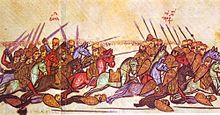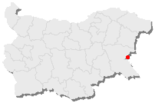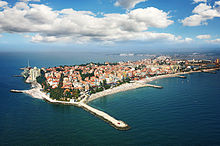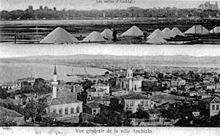Pomorie
| Pomorie (Поморие) | |||
|
|||
| Basic data | |||
|---|---|---|---|
| State : |
|
||
| Oblast : | Burgas | ||
| Residents : | 13,607 (December 31, 2016) | ||
| Coordinates : | 42 ° 34 ' N , 27 ° 38' E | ||
| Height : | 0 m | ||
| Postal code : | 8200 | ||
| Telephone code : | (+359) 0596 | ||
| License plate : | A. | ||
| Administration (as of November 2011) | |||
| Mayor : | Ivan Aleksiev | ||
| Ruling party : | GERB | ||
| Website : | pomorie.bg | ||
Pomorie ( Bulgarian Поморие ) is a Bulgarian coastal city on the Black Sea . The city is located in the Burgas Oblast and is the center of a municipality of the same name. Pomorie has 13,607 inhabitants (as of December 31, 2016) and is a popular tourist and wellness center .
geography
location
The city is located in the eastern part of the Upper Thracian Plain in the Bay of Burgas on an approximately 5 km long peninsula. From the north it is surrounded by Lake Pomorie of the same name . Pomorie is located about 20 km north of Burgas city center , about 8 km from Burgas Airport and about 18 km south of Nessebar .
Pomorie is divided by a channel that connects Lake Pomorie with the Black Sea. The eastern part forms the old town (bulg. Стар град / Star grad) and the part to the west of the canal is the new town (bulg. Нов град / Now grad).
Neighboring communities
The city borders the Black Sea to the northeast, east, southeast and south. The following cities and municipalities, all of which are in the province of Burgas, border the city of Pomorie:
| Kableschkowo | Acheloj | |
| Burgas |

|
|
|
Burgas Sarafovo |
nature
To the north of the city is the Lake Pomorie Nature Park, which is part of the Burgas Wetlands project . In the lake, which is actually a lagoon , many endangered bird species overwinter , using the east north-south migration route for migratory birds , the Via Pontica . There are several bird watching spots in the nature reserve, which are freely accessible.
history
City history
Antiquity

Today's Pomorie can look back on thousands of years of history. Like most cities in the region, Pomorie arose from a Thracian settlement.
In the 5th century BC The settlement Apollonia was incorporated into which a fortress was built, which was named "Anchialos" ( Greek Αγχίαλος , translated near the salt ). The location of this fortress is unknown, it is believed to be northwest of the city. Since this stretch of land is now below sea level, it has hardly been explored so far.
In the following time the city was settled and expanded by Doric colonists. Salt mines were built near the city in ancient times and are still in use today. Control of the mines and the trade in salt broke out in the 2nd century BC. A war between Apollonia and Mesembria . The Thracian grave that is accessible today dates from this period.
Between the 1st century BC BC and the 1st century AD, the city became part of the Odrysen Empire and the center of a strategy (province).
The city was best known when it was incorporated into the Roman Empire at the end of the 1st century AD under Emperor Trajan . The Romans had the city built a little further away on the mainland in the Paleocastro area. The city rose to the second most important port in the province of Haemimontus after Deultum . The Roman fortress was called Ulpianon Anchialeon and was one of the largest in the present day Bulgaria. The city was famous for its wealth under the Romans. It became the bishopric and was allowed to mint its own coins.
Around 270 the city was conquered and destroyed by the Goths . Between October 28 and 30, 294, Emperor Diocletian visited the city and ordered its reconstruction.
middle Ages


In 590 the city, which had meanwhile been destroyed by the Avars and Slavs , was visited by the Eastern Roman Emperor Maurikios as part of a reconstruction program , which was the start of his campaigns in the Balkans .
In 708 the first battle of Anchialus took place at the gates of the city , in which the Bulgarian ruler Khan Terwel defeated the advancing army of the Byzantine emperor Justinian II .
In 740 the city was destroyed by a natural disaster, but was rebuilt after a decree by the Byzantine Empress Irene .
In 753 the Bulgarian ruler Telez defeated the Byzantine troops at the gates of the city in the second battle of Anchialus .
In 812 Anchialus was incorporated into the First Bulgarian Empire under Khan Krum and renamed Tutchon .
The third battle of Anchialus took place near the city on August 20, 917 , in which the Bulgarian Tsar Simeon I inflicted one of the greatest defeats in history on the Byzantine army. After this victory, Simeon declared himself - according to the imperial title - the " Tsar (Gr. Basileos , dt. Emperor) of the Bulgarians and Rhomeans " (= Eastern Romans), as the Byzantines called themselves. After this defeat, the Byzantine Empire had little to oppose the Bulgarians for a long time.
Only after the fall of the First Bulgarian Empire could Byzantine rule be restored. A hundred years later, the Second Bulgarian Empire took the stage. In the following period the rule of the city changed several times between Bulgarians and Byzantines. In the 13th century the Catalan Company raged in the area. Only when in October 1366 Amadeus VI. of Savoy conquered the city from the Bulgarians in the course of a campaign against the Turks and then sold it to Byzantium, it finally came into Byzantine possession.
Ottoman rule
Anchialus fell under the rule of the Ottoman Turks in 1453, together with Nessebar and the entire southern Black Sea coast, as one of the last cities in present-day Bulgaria. During the centuries of rule, the city and its surrounding area were the second most important salt mining area within the empire after Thessaloniki . The city was also the center of a judicial and administrative district ( Kaza ). During this time Anchialos was the center of an eparchy of the ecumenical patriarchate of Constantinople and the cultural, religious, economic and administrative center of the region until the beginning of the 19th century. After the fall of Constantinople in 1453, several important Byzantine families, such as the palaeologists , settled here . The later ecumenical patriarch of Constantinople Jeremias II Tranos comes from another family .
In the Russo-Ottoman War (1828-1829) the city was captured on July 11, 1829 by Russian troops. Most of the city's residents were Greeks and Bulgarians and supported the Russians. When it became known after the Peace of Adrianople that the city would remain in the Ottoman-Turkish Empire, many residents fled from the advancing Turks.
In 1856 the “Sweti Georgi” monastery was inaugurated.
After the Turkish rule
The Turkish rule ended in Anchialos on January 27, 1878. After the Peace of San Stefano and its revision by the Berlin Congress , the city became part of the autonomous province of Eastern Rumelia until its union with the Principality of Bulgaria in 1885. In the following time it was administratively incorporated into the Burgas district.
After the Ilinden-Probraschenie uprising of 1903, the city took in a large number of Bulgarian refugees who were expelled from Macedonia (→ Macedonian Bulgarians ) and Thrace (→ Thracian Bulgarians ) in what is now northern Greece and Turkey .
On July 30, 1906, the Greek quarter of the city, in response to an attack by Greek militants on the village of Sagortschani (today Vasiliada in northern Greece ) and the subsequent bloodbath against the Bulgarian population there ( Sagoritschani massacre ), was evacuated by Bulgarian refugees Areas lit. However, the fire destroyed almost the entire city, so that old houses of rebirth have only been preserved in the eastern part. Almost all of the surviving Greek population emigrated to Greece, where they founded places like Nea Anchialos (New Anchialos) or Anchialos.
In the next few years, ethnic Bulgarians (Thracian Bulgarians and Macedonian Bulgarians) settled in northern Greece ( Western Thrace ) and Turkey according to the treaties of Sèvres , Neuilly-sur-Seine and Lausanne as well as after the Balkan and World Wars ( Eastern Thrace ) had lost. However, the city could not recover economically, which was due to the connection of Burgas to the railway line to Plovdiv and the open sea port in Burgas in 1903.
The city recovered slowly over the next few decades. In 1934 Anchialos was renamed Pomorie , which means close to the sea in Bulgarian . During the Second World War, the German Wehrmacht built a railway line from Burgas via Pomorie to Varna . Construction ended at the end of the war. After that, Pomorie was connected to the Bulgarian railway network, but only freight trains (which were mainly loaded with salt) ran in the direction of Burgas. Today the old track has been almost completely dismantled and many of the railway systems are in ruins. Several local companies are based on the former railway site, for example for sewer construction or for the handling of wholesale goods.
present
Today, Pomorie is surrounded by vineyards and orchards and is one of the most famous bog and seaside resorts in Bulgaria. The city center is located on the peninsula. The new town is also expanding, especially towards Burgas. In the old town there are still the typical cobblestone streets and the characteristic Black Sea houses from the 19th century in the style of the Bulgarian Revival - mostly roughly square, two-story houses with hipped roofs, the lower floor of which is made of light-colored stone, the upper floor of dark-painted wood is. The "Sweti Georgi" (Saint George ) monastery is located between the old and new city districts .
Since the end of communist rule, tourism in Pomorie and the surrounding area has increased significantly. Today the city is mainly visited by families who appreciate the flat beaches in the immediate vicinity. In contrast to the nearby Sunny Beach and the Nessebar Peninsula , the city has not become a destination for mass tourism. Wellness tourism has also increased significantly in recent years . The healing mud obtained from Lake Pomorie is used in many newly established sanatoriums and spa hotels for the treatment of nerve, vein or joint problems.
Extensive construction activity resulted in many multi-story houses with apartments being built north of the old town, which were sold to foreign investors. The infrastructure between these apartment blocks has not yet been completely built, the streets are usually provisionally piled up on their own by the builders, which often leads to unnatural height differences between a sidewalk and the street. The former Little Pomoriesee has already been completely filled in. Many of the foreign buyers of these properties are of Russian nationality.
Pomorie is also known for its excellent wines . The city is located in the middle of the Black Sea wine-growing region , which is characterized by a long and mild autumn. The grape varieties Dimyat , Riesling , Muscat Ottonel , Ugni blanc , Sauvignon Blanc , Cabernet Sauvignon , Chardonnay and Gewürztraminer are grown here.
The city has given its name to Pomorie Point , a headland on Livingston Island in Antarctica , since 2004 .
Population development
The changing population figures partly result from the respective territorial status.
|
|
|
The numbers come from:
- Censuses (¹),
- Estimates (²) or
- official updates of the statistical offices (³).
politics
mayor
In the local elections of 2011, the candidate of the GERB party Ivan Aleksiev was elected mayor in the second ballot by 62.60 percent of the voters (8256 votes).
City council
The city council of Pomorie consists of the mayor and the number of 21 city council members required by the municipal code. The city council is re-elected every four years, the next election is in 2019. Since the penultimate local elections on October 23, 2011, with a turnout of 64.57 percent, the distribution of seats in the city council is as follows:
| Political party | Election result 2011 | Votes | Seats |
|---|---|---|---|
| GERB | 26.87% | 3629 | 9 |
| Dwischenie sa Prawa i Swobodi | 13.60% | 1837 | 4th |
| Political Movement Social Democrats | 7.11% | 961 | 2 |
| Bulgarian Socialist Party | 6.76% | 913 | 2 |
| National Movement for Stability and Progress | 6.00% | 811 | 2 |
| Order, security and justice | 4.80% | 649 | 2 |
Community structure
The city council also functions as the local council and is responsible for overseeing all mayors of the localities. The municipality Pomorie (. Bulg Община Поморие / Obschtina Pomorie) also includes the cities still Acheloj and kableshkovo and the following villages:
Town twinning
Economy and Infrastructure
Pomorie has a port, two bus stations (one in the old and one in the new town) and a freight station. The passenger station that served the Burgas-Pomorie railway line was shut down in the 1990s.
Education and culture houses
There are two day-care centers in Pomorie, the "Christo Botew" elementary school, the general high school "Iwan Wassow" and a vocational school for tourism "Aleko Konstantinow". For further subject-related and further education facilities, the children visit schools in Burgas (→ Education and Research in Burgas ).
There are also two cultural centers in Pomorie: the Tschitalischte "Prosweta" and the Tschitalischte "Swetlina".
Culture and leisure
Cultural events
- May 6th - city festival
- Every year, Pomorie hosts the International Festival of Orthodox Music. Various church choirs from Bulgaria, Russia, Ukraine and Serbia will travel to this event. The competition takes place in the Church of Our Lady in the center of the old town of Pomorie.
- August - Joworow days, poetry festival in memory of Pejo Jaworow
Attractions
- Aquae Calidae - The baths of Aquae Calidae were demonstrably visited by several important rulers in the course of history, in addition to Philip II of Macedonia, among others, the Eastern Roman emperors Justinian I and Constantine IV , the Bulgarian ruler Terwel and the Ottoman sultan Suleyman I.
- Thracian tomb - in the plain in front of Pomorie there are numerous settlement mounds (so-called mogila ) and tombs. To the southwest of the new town in the Paleocatro area , near the road from Pomorie to Burgas, there is an ancient cupola tomb. It is believed that it served as a mausoleum for a wealthy family from Roman Anchialus.
- historical Museum
- Salt museum and observation center
- Partisan Museum
- "Sweti Georgi" monastery
- Mother of God Church
- Church of the Ascension
Sports and sports facilities
The soccer club Chernomorets Pomorie plays in the Bulgarian W Grupa in the 2012/13 season . The greatest success of the club, founded in 1944, was participation in the cup final in the 2009/10 season. Chernomorets Pomorie plays its home games in the Pomorie Stadium .
People associated with the city
- Michael III of Anchialus , Patriarch of Constantinople (1170–1177)
- Jeremias II. Tranos, Patriarch of Constantinople (1572–1579, 1580–1584, 1587–1595)
- Pejo Jaworow , poet (1878–1914)
literature
- Peter Soustal: Thrace (Thrace, Rhodope and Haimimontos) (= Tabula Imperii Byzantini Volume 6). Publishing house of the Austrian Academy of Sciences, Vienna 1991, ISBN 3-7001-1898-8 , pp. 175–177.
- Jan Burian, Eckhard Wirbelauer : Anchiale 2. In: The New Pauly (DNP). Volume 1, Metzler, Stuttgart 1996, ISBN 3-476-01471-1 , Sp. 676 f.
- Mikhail Lazarov: Istorija na Pomorie. 1 Anchialo ot drevnostta do osvoboẑdenieto. Fondacija "25 veka Pomorie", Pomorie, 2000.
- Mikhail Lazarov: Pomorie. The old Anhialo. Slavena, Varna, 2005, ISBN 954-579-466-6 .
- Manfred Oppermann : Thracians, Greeks and Romans on the west coast of the Black Sea (= Zabern's illustrated books on archeology ), Zabern, Mainz, 2007, ISBN 978-3-8053-3739-7 .
Web links
- More information about Pomorie (English)
- More information about the city and the region (German)
- The Sweti Georgi Monastery in Pomorie
Individual evidence
- ^ Ralph F. Hoddinott: Bulgaria in Antiquity. An archeological introduction. Ernest Benn, London 1975, ISBN 0-510-03281-8 , pp. 222-223.
- ↑ The Little Pomoriesee on Googlemaps
- ↑ Pomorie Population by Year , National Bureau of Statistics, accessed May 22, 2012
- ↑ a b Central Election Commission: Final results of the 2011 local elections in Pomorie. (No longer available online.) Archived from the original on February 1, 2012 ; Retrieved May 29, 2012 (Bulgarian). Info: The archive link was inserted automatically and has not yet been checked. Please check the original and archive link according to the instructions and then remove this notice.
- ↑ Pomorie and Tekirdağ renew the town twinning (Bulgarian) ( Memento of the original from February 25, 2016 in the Internet Archive ) Info: The archive link has been inserted automatically and has not yet been checked. Please check the original and archive link according to the instructions and then remove this notice.
- ↑ a b Education and childcare in Pomorie , school portal uchilishta.guide-bulgaria.com, accessed on May 31, 2012
- ^ Official website of the Festival for Orthodox Church Music












